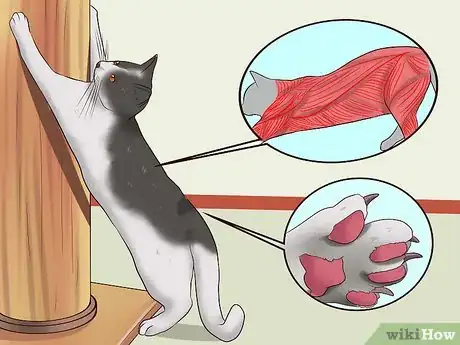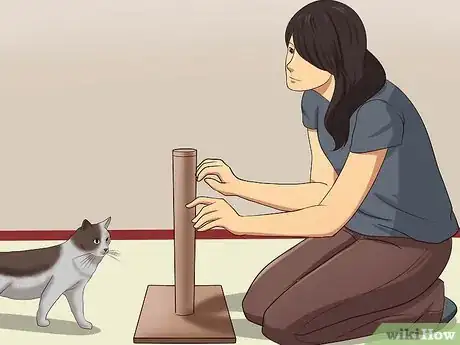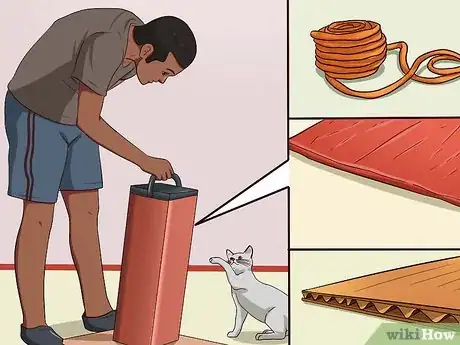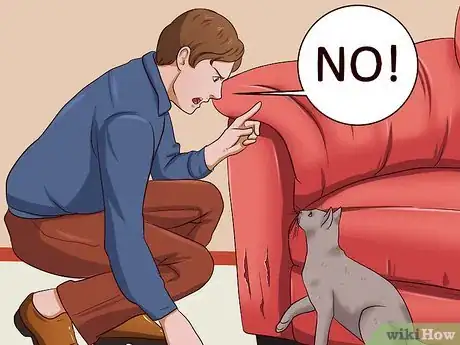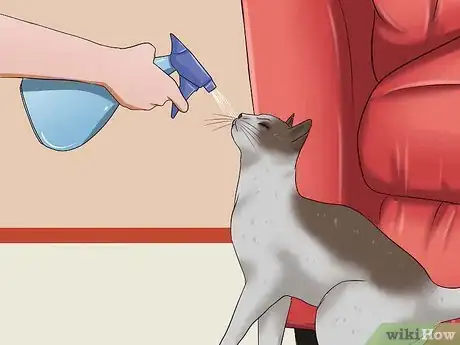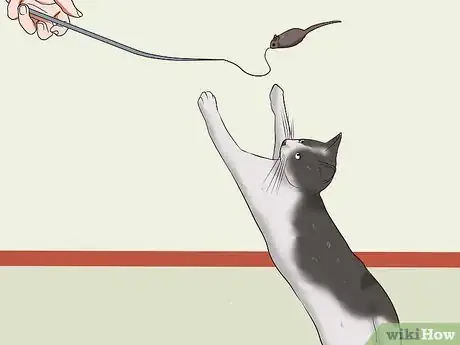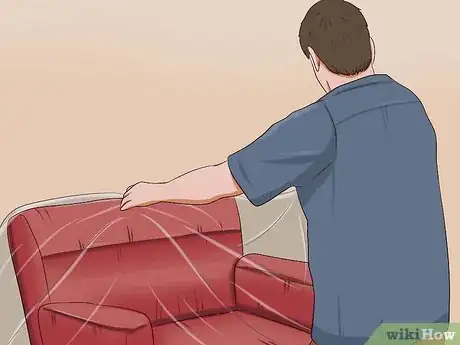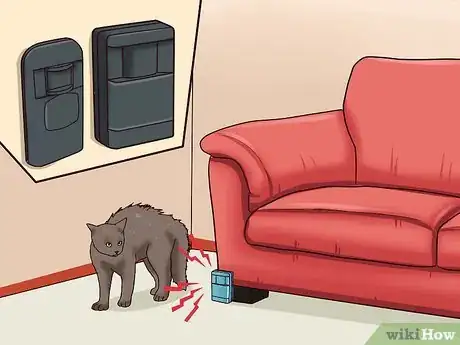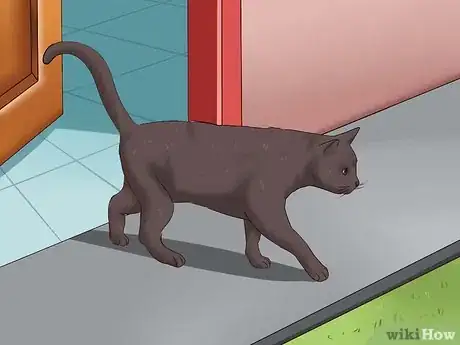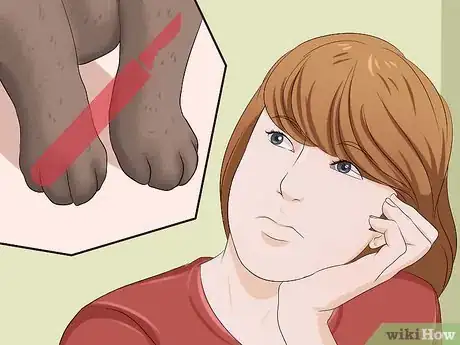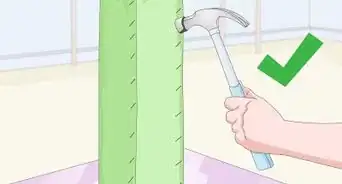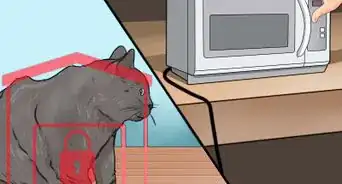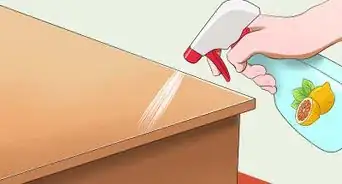This article was co-authored by Brian Bourquin, DVM. Brian Bourquin, better known as “Dr. B” to his clients, is a Veterinarian and the Owner of Boston Veterinary Clinic, a pet health care and veterinary clinic with three locations, South End/Bay Village, the Seaport, and Brookline, Massachusetts. Boston Veterinary Clinic specializes in primary veterinary care, including wellness and preventative care, sick and emergency care, soft-tissue surgery, dentistry. The clinic also provides specialty services in behavior, nutrition, and alternative pain management therapies using acupuncture, and therapeutic laser treatments. Boston Veterinary Clinic is an AAHA (American Animal Hospital Association) accredited hospital and Boston’s first Fear Free Certified Clinic. Brian has over 19 years of veterinary experience and earned his Doctor of Veterinary Medicine from Cornell University.
There are 14 references cited in this article, which can be found at the bottom of the page.
wikiHow marks an article as reader-approved once it receives enough positive feedback. This article received 12 testimonials and 80% of readers who voted found it helpful, earning it our reader-approved status.
This article has been viewed 1,832,308 times.
Cats clawing on furniture and other household furnishings may be purely destructive behavior from your point of view but not from the cat's point of view. To them it's natural behavior, following a need to keep their claws in top shape and to leave visual and scent markings on the object, communicating territory boundaries to other cats and other animals. In addition, scratching provides a form of exercise for cats, stretching and retracting their shoulders, legs, and paws.[1] Because scratching is a natural activity for cats, protecting your furniture and other household goods may take a little ingenuity and effort on your behalf but is not impossible.
Steps
Understanding and Redirecting Scratching Behavior
-
1Appreciate the purpose of scratching or clawing. A cat doesn't scratch to give you grief. A cat scratches because it's a form of exercise for the cat's muscles from the claws right through to the legs, shoulders, and down the back.[2] In addition, scratching also sharpens the cat's claws and cleans the exterior sheath.
- Cats also scratch to scent-mark territorial areas with their paws, which have scent glands usually indistinguishable to humans, but very distinct to other cats, dogs, and many other pets and animals.
-
2Be patient and be understanding. You love your cat and the precious bond both of you share. Cats know when you care and will reciprocate. They will do their best to please their human companions, provided they know they're supported and praised.
- Over time, with repeated loving practice, your cat should become used to leaving the furniture alone and using alternatives for their scratching.
Advertisement -
3Purchase at least one scratching post (or other scratching apparatus) for your cat. A scratching post is the answer to your scratching problem, but it will take time to encourage your cat to use it.
- When purchasing the scratching post, there are some things to consider initially. Look for one that is at least as tall as your cat when he/she stands on his/her hind legs. Ensure that it is sturdy and cannot wobble when pressure is applied to it by your cat. Make sure that the scratching post isn't heavy and tall, or it may fall on your cat.
- Scratching boards and posts come in different sizes and uses. Some are flat on the floor and some are raised. Some are made of hemp. Try different types. It is better to have too many around, than not enough.
- Some cats prefer to scratch on a horizontal surface like the carpet. Orientate the scratch post horizontally or vertically to match their preference and they will be more likely to use it. There are cardboard, sisal, and carpet based options for horizontal surfaced scratching. [3]
- Whatever you choose, avoid anything fluffy. A cat's scratching post must be like tree bark (their natural scratching element), rough and coarse.[4] Posts with sisal fiber rope wound around them are best, and the scratchier it is, the less inviting your heirloom needlework pieces will seem.
EXPERT TIPBrian Bourquin, better known as “Dr. B” to his clients, is a Veterinarian and the Owner of Boston Veterinary Clinic, a pet health care and veterinary clinic with three locations, South End/Bay Village, the Seaport, and Brookline, Massachusetts. Boston Veterinary Clinic specializes in primary veterinary care, including wellness and preventative care, sick and emergency care, soft-tissue surgery, dentistry. The clinic also provides specialty services in behavior, nutrition, and alternative pain management therapies using acupuncture, and therapeutic laser treatments. Boston Veterinary Clinic is an AAHA (American Animal Hospital Association) accredited hospital and Boston’s first Fear Free Certified Clinic. Brian has over 19 years of veterinary experience and earned his Doctor of Veterinary Medicine from Cornell University.Veterinarian
 Brian Bourquin, DVM
Brian Bourquin, DVM
VeterinarianOur Expert Agrees: If you want to prevent a kitten from scratching, get both a horizontal and a vertical scratching post and teach the cat to use it very early on. There are even products you can spray onto the scratching post that will attract the cat to that area.
-
4Locate scratching posts strategically. Figure out which pieces of furniture the cat has clawed and their locations. Make sure the scratching apparatus is prominently featured in the room and next to any furniture the cat seems to prefer scratching.
- If you have just gotten a cat, place the post where it might be likely that a new cat would try to scratch.
- If the cat is marking and scratching in multiple areas, create “good” scratching opportunities in each of those areas. It's a really good idea to have more than one scratching post, especially if you have upstairs and downstairs areas, your house is large, or you have more than one cat. This will lessen the probability that your cat will resort to furniture in other rooms without scratching posts.
- If your cat is always scratching the chair you sit in most, locate a scratching post near it. You could also leave a piece of your laundry on the top of the scratching post for a while, or use its top tray as a drop spot for personal items, so that your cat sees it as part of your territorial marker, like your favorite chair. This is especially relevant if your cat is extremely attached to one person in the household. Putting the scratching post or cat tree in close contact with their favorite sofa or chair can make it even more enticing.
-
5Train your cat to use the scratching post. Condition your kitten or cat to use the scratching post and nothing else for scratching. Encourage your cat to unleash his claws on the new scratching post by gently placing him in front of it. At the same time, gently stroke him and wait for him to respond to the post in front of him.
- If you want to make the post more inviting, rub catnip or spray catnip oil onto the post.[5]
- Every time your cat uses the scratching post, offer it praise and give it a pat and a treat.[6] Some suggest that you encourage your cat by gently placing his front paws onto the post and even moving the paws up and down on it, but warn that many cats hate being forced to do anything and this can have a very negative effect.[7]
- Alternatively, you could even "show" your cat how to scratch using your own fingernails.
- You can also dangle a toy over the scratching post so that it bangs against the post. This should draw your cat's attention to the pole; In swiping at the toy, he or she may discover the joy of scratching the pole behind it.
- Another method of conditioning your cat to like their scratching post is to withhold your greeting upon returning home until you reach the scratching post. Stand at the post and scratch it with your nails, telling your cat how happy you are to see them. When they come near the post and start clawing it, stop scratching it yourself and start stroking the cat while they scratches the post, all the while praising them for being such a good cat.[8]
-
6Adjust the position and type of the scratching post as needed. Feel free to move the post around a bit if your cat is not paying attention to it. Don't try to force the cat to like it as it is, instead personalize the post to your cat's likes.
- For instance, if you notice your cat exhibiting nervousness or dislike of the scratching post, try tilting it onto its side. This will make it smaller and less threatening while the cat gets used to it.[9]
- Cats develop preferences for scratching surfaces or substrates. Use the surface your cat prefers. This may be sisal rope, carpeting, cardboard, or drapery fabric or something else entirely. Transitioning your cat to a new scratching post or surface will be much more successful if you work with your cat’s tendencies, not against them.
Halting Bad Scratching Behaviors
-
1Use your tone of voice to correct their behavior. A sharp "NO!" whenever your cat goes anywhere near a clawed piece of furniture can help to reduce his interest in clawing it.[10] Be aware, however, that the cat may only learn not to scratch when you are present, and may continue to scratch in your absence since they link the punishment directly to you.
- Another way to curb clawing is to toss a can of pebbles or pennies to land near the cat (do not throw it at them) to startle them. Try not to let the cat see that you threw it. This way, it appears triggered by the scratching, and has nothing to do with you. That way the cat is less likely to scratch when you are away, because they don't associate you directly with the punishment.
- Then, pick them up and place them next to the scratching pole as a means of conditioning.
- Don't sound angry or go into a nasty tirade against your cat; remember they are simply following instincts and you're the higher-level being with the ability to control your emotional outburst.
- Never scold your cat when they are near or using the scratching post. They need to associate the scratching post with all things pleasant and happy.
EXPERT TIPBrian Bourquin, better known as “Dr. B” to his clients, is a Veterinarian and the Owner of Boston Veterinary Clinic, a pet health care and veterinary clinic with three locations, South End/Bay Village, the Seaport, and Brookline, Massachusetts. Boston Veterinary Clinic specializes in primary veterinary care, including wellness and preventative care, sick and emergency care, soft-tissue surgery, dentistry. The clinic also provides specialty services in behavior, nutrition, and alternative pain management therapies using acupuncture, and therapeutic laser treatments. Boston Veterinary Clinic is an AAHA (American Animal Hospital Association) accredited hospital and Boston’s first Fear Free Certified Clinic. Brian has over 19 years of veterinary experience and earned his Doctor of Veterinary Medicine from Cornell University.Veterinarian
 Brian Bourquin, DVM
Brian Bourquin, DVM
VeterinarianNever punish your cat. Use redirection if your cat is scratching, but never yell at it, shake it, or hit it. Cats aren't by nature as trusting as dogs, so yelling at your cat can really damage your bond with it. Remember that cats don't scratch to be destructive; they just can't trim their claws on their own.
-
2Use water to stop your cat's bad behavior. If you have a spray bottle of water, you could try squirting your cat whenever they go near the furniture and start scratching it.[11] Aim to do this before they start scratching but if not, squirt mid-scratch. This won't hurt the cat but it will help them to associate scratching that piece of furniture with a less-than-pleasant spritz of water!
- Again, this can also cause the cat to link your presence to getting sprayed, so they may do their scratching when you are not there.
- You can also use a citrus oil mix to deter your cat. Some cats are repelled by the scent of orange oil. Mix equal parts, about a cap-full each, of eucalyptus oil and orange oil in a spray bottle of water. You can test this on your cat by putting a small amount on a damp cloth and present it close to their nose. You will need to shake the contents before each use as the oil and water will separate after a short time. Using this method not only helps to deter your cat from destroying furniture or walls, but gives your house a pleasant and fragrant odor as well.
-
3Redirect your cat's attention. Sometimes you will just need to physically stop the cat from scratching. Remove them from where they are scratching and give them something else to do. Try giving them a toy to play with or petting them for awhile, whatever they enjoy more than scratching.
Limiting Your Cat's Access to the Items They Want to Scratch
-
1Cover problem furniture. Some pieces just seem to get marked for special scratching treatment because they feel just right to your cat. In this case, there are several options you can try:
- Apply double-sided tape to the furniture.[12] Cats dislike the sticky feeling and won't continue to stick their claws wherever it's sticky, as the hairless skin of the cat's paws is extremely sensitive to touch.[13]
- For larger furniture, adhere masking tape over the arms, or on the back of the furniture where the cat will often enjoy playing (and hiding from water spritzing).
- For a larger area, such as a rug or carpet, leave contact sheets sticky side up over the surface you want to protect.[14]
- You can also buy a product called "Sticky Paws," which are medical grade adhesive sticky strips that can go on curtains, drapes, carpets, and anything else that might be a bit too tempting for your cat.[15]
- Use the “knobby” side of a plastic or vinyl floor runner along the back of the couch to deter scratching. The cat won’t like the feel of the pointy knobs on their feet.
- For cats who seem to live it up when you're at work or away from home, cover the furniture in plastic covers. Cats are not fond of walking over plastic because of its smell and feel.[16] You could also try placing blown-up balloons hidden underneath a sheet covering the furniture which will burst when clawed, causing the cat a fright that will be associated with that piece of furniture long after the balloon has popped.[17]
- If buying new furniture, consider getting a tight weaved chenille or microfiber fabric as opposed to a tweed-like fabric. Cats will not be interested in those types of fabrics as they won't be able to get their claws through. Cats will scratch any furniture made with a thin loose-weaved fabric.
- Also consider using a “Scat mat” to deter cats from certain surfaces and areas.
-
2Consider creating a deterrent to certain areas with the help of a motion detector attached to a spray or ultrasonic noise. It is generally recommended to correct your cat remotely so that they do not associate the negative correction with you or other humans. Otherwise, you will create fear in the cat toward humans and likely train the cat to scratch in secret.
- These products can be found online at various retailers.
-
3Shut doors to rooms with very special furniture, furnishings, and objects. If you have antiques or furniture that is of great value, consider leaving it in a cat-free zone. Ensure that everyone in the family is aware that the cats must not be let into that area or room and always keep doors to these areas closed. Ask the humans in the house to take care rather than expecting the cat to know the difference between important furniture and less important furniture.
- If the cat does wander in, shoo him out abruptly so that he associates it with being "out of bounds."
Limiting Your Cat's Ability to Scratch
-
1Keep your cat's claws neatly trimmed. Since part of the reason for scratching is to sharpen and even shorten claw growth, you can help out with a regular, careful trim of your cat's claws.
- If you don't know how to clip a cat's claws, ask your vet to show you how to do this the first time, as it is easy to hurt the cat badly if you don't what you're doing.[18] [19]
- A cat that is not used to claw clipping can be a little bothered by it initially but you need to persevere until they are comfortable with it. Again, praise your cat while your are trimming their claws so that they know you are caring.
- It is useful to "blunt" the tips of the claws of an indoor cat that never has access to outdoor trees. You can do this with toenail clippers (never use claw clippers made for dogs) but you must know the correct cutting line to avoid injuring the cat. Ask your veterinarian or a groomer to show you this for the first time.[20]
EXPERT TIPBrian Bourquin, better known as “Dr. B” to his clients, is a Veterinarian and the Owner of Boston Veterinary Clinic, a pet health care and veterinary clinic with three locations, South End/Bay Village, the Seaport, and Brookline, Massachusetts. Boston Veterinary Clinic specializes in primary veterinary care, including wellness and preventative care, sick and emergency care, soft-tissue surgery, dentistry. The clinic also provides specialty services in behavior, nutrition, and alternative pain management therapies using acupuncture, and therapeutic laser treatments. Boston Veterinary Clinic is an AAHA (American Animal Hospital Association) accredited hospital and Boston’s first Fear Free Certified Clinic. Brian has over 19 years of veterinary experience and earned his Doctor of Veterinary Medicine from Cornell University.Veterinarian
 Brian Bourquin, DVM
Brian Bourquin, DVM
VeterinarianOur Expert Agrees: Cats scratch to trim their claws, so to help prevent scratching, trim off the curved part of the nail regularly. If you're not sure how to do it, visit your vet and ask them to show you how.
-
2Use plastic caps to cover your cat’s nails. “Soft Paws” glued to your cat’s nails will prevent the cat from damaging surfaces because the cap covers the sharp nail. You can glue these on yourself, or have your veterinarian do it for you. These caps will eventually fall off in three to six weeks and need to be reapplied.
-
3Allow your cat some outside time where possible. If your cat is already able to go in and out of the house, it is highly likely that they have found themselves a tree or two to scratch on. Encourage this (unless it's harming the tree) and continue to let them have appropriate outside time, as using nature for a scratching post will definitely reduce their desire to use your furniture as one.
-
4Consider the downsides and alternatives to declawing your cat before having it done. Declawing can be a quick and easy way to prevent furniture damage, however, it is a surgery, and like all medical procedures, comes with risks.
- While it is still legal to declaw a cat in most (but not all) cities in the United States and Canada, there are some ethical considerations. Declawing is considered to be an act of cruelty, and is thus illegal in Europe and other countries. A significant proportion of cats having undergone declawing refuse to use the cat litter, develop aggressive behaviour (mainly biting and hissing), and show signs of intense stress and fear. It also makes them more vulnerable to predators, and does not allow them to stretch properly. Do your research and make sure that you understand all that you need to know in order to make the decision to amputate the ends of your cat’s toes.[21] [22]
- The declawing procedure involves amputating the digit at the last joint of your cat’s front paws. Talk to your veterinarian if you think declawing is your choice. Some cats do fine but others suffer from chronic pain and, later, arthritis.[23]
- Note that if you have a cat that goes outdoors, declawing their front paws may affect their ability to climb and defend themselves.[24]
- Check the adoption or purchase contract for your cat. Some rescue groups and adoption agencies have “do not declaw” clauses in the contract you signed to allow your cat to live in your home.
Expert Q&A
-
QuestionI have a rescue cat who claws the furniture. When I shout, she acts scared. I now use a spray bottle of water, but is there something else I can do to make her less frightened so I can train her easier?
 Pippa Elliott, MRCVSDr. Elliott, BVMS, MRCVS is a veterinarian with over 30 years of experience in veterinary surgery and companion animal practice. She graduated from the University of Glasgow in 1987 with a degree in veterinary medicine and surgery. She has worked at the same animal clinic in her hometown for over 20 years.
Pippa Elliott, MRCVSDr. Elliott, BVMS, MRCVS is a veterinarian with over 30 years of experience in veterinary surgery and companion animal practice. She graduated from the University of Glasgow in 1987 with a degree in veterinary medicine and surgery. She has worked at the same animal clinic in her hometown for over 20 years.
Veterinarian Clawing is natural behavior so the cat won't understand why she is being punished. This causes confusion, anxiety, and ultimately distress, so try only to resort to punishment if she is in danger of hurting herself. Instead, follow the tips in this guide, but pay special attention to giving her alternative safe places to scratch. Make the sofa less attractive to scratch by covering it with a plastic sheet when you aren't there.
Clawing is natural behavior so the cat won't understand why she is being punished. This causes confusion, anxiety, and ultimately distress, so try only to resort to punishment if she is in danger of hurting herself. Instead, follow the tips in this guide, but pay special attention to giving her alternative safe places to scratch. Make the sofa less attractive to scratch by covering it with a plastic sheet when you aren't there.
Warnings
- Put your scratching post somewhere firm, so that it cannot topple over when the cat or kitten uses it.⧼thumbs_response⧽
- Never yell at a cat. That only serves to weaken your relationship with it. They don't understand it as punishment or avoidable. They just see it as you being loud and hot tempered. Their usual response is to just get out of your way till you're done being mad and than go on doing whatever they did that you yelled about.⧼thumbs_response⧽
- Have patience with your cat. If you feel you just cannot stand them anymore, contact your veterinarian for further advice on an animal behaviorist. A cat trainer or declawing should not be necessary if you use patience and diligence in training your cat.⧼thumbs_response⧽
Things You'll Need
- Scratching post or horizontal or vertical surface, depending on your cat's preference
- Catnip, catnip oil/essence
- Double-sided tape
- Cat toys
- Spray bottle with water
- Towel to help restrain while with cutting nails (if necessary)
- Orange oil (Optional)
References
- ↑ Caroline Davis, The Essential Cat, p. 35, (2005), ISBN 0-7621-0496-1
- ↑ Anitra Frazier, The Natural Cat: The Comprehensive Guide to Optimum Care, p. 111, (2008), ISBN 978-0-452-28975-8
- ↑ http://www.catbehaviorassociates.com/horizontal-scratching/
- ↑ Anitra Frazier, The Natural Cat: The Comprehensive Guide to Optimum Care, p. 111, (2008), ISBN 978-0-452-28975-8
- ↑ Caroline Davis, The Essential Cat, p. 35, (2005), ISBN 0-7621-0496-1
- ↑ Bash Dibra, Cat Speak, p. 178, (2001), ISBN 0-399-14741-1
- ↑ Anitra Frazier, The Natural Cat: The Comprehensive Guide to Optimum Care, p. 114, (2008), ISBN 978-0-452-28975-8
- ↑ Anitra Frazier, The Natural Cat: The Comprehensive Guide to Optimum Care, p. 115, (2008), ISBN 978-0-452-28975-8
- ↑ Anitra Frazier, The Natural Cat: The Comprehensive Guide to Optimum Care, p. 114, (2008), ISBN 978-0-452-28975-8
- ↑ Bash Dibra, Cat Speak, p. 179, (2001), ISBN 0-399-14741-1
- ↑ Bash Dibra, Cat Speak, p. 179, (2001), ISBN 0-399-14741-1
- ↑ Bash Dibra, Cat Speak, p. 179, (2001), ISBN 0-399-14741-1
- ↑ Caroline Davis, The Essential Cat, p. 128, (2005), ISBN 0-7621-0496-1
- ↑ Bash Dibra, Cat Speak, p. 179, (2001), ISBN 0-399-14741-1
- ↑ Anitra Frazier, The Natural Cat: The Comprehensive Guide to Optimum Care, p. 115, (2008), ISBN 978-0-452-28975-8
- ↑ Bash Dibra, Cat Speak, p. 179, (2001), ISBN 0-399-14741-1
- ↑ Bash Dibra, Cat Speak, p. 179, (2001), ISBN 0-399-14741-1
- ↑ Paddy Cutts, The Complete Cat Book, p. 52, (2003), ISBN 1-84309-089-9
- ↑ Caroline Davis, The Essential Cat, p. 35, (2005), ISBN 0-7621-0496-1
- ↑ Paddy Cutts, The Complete Cat Book, p. 53, (2003), ISBN 1-84309-089-9
- ↑ https://www.avma.org/KB/Policies/Pages/Declawing-of-Domestic-Cats.aspx
- ↑ Jen Swiderski, Onychectomy and its alternatives in the feline patient; Clinical Techniques in Small Animal Practice, Vol 17, No 4 (November), 2002: pp 158-161.
- ↑ http://www.veterinarypartner.com/Content.plx?P=A&S=0&C=0&A=568
- ↑ http://www.veterinarypartner.com/Content.plx?P=A&S=0&C=0&A=668
- ↑ Paddy Cutts, The Complete Cat Book, p. 52, (2003), ISBN 1-84309-089-9
About This Article
To stop a cat from clawing furniture, put a scratching post next to any furniture your cat likes to scratch. Then, rub some catnip on the posts so your cat is more interested in using them. If you catch your cat clawing the furniture, pick it up and move it to the nearest scratching post. You can also try putting double-sided tape on the furniture, which will deter your cat from scratching it since it won't like the feeling of the tape on its claws. For more tips, like using sprays or loud sounds to deter your cat, keep reading!
